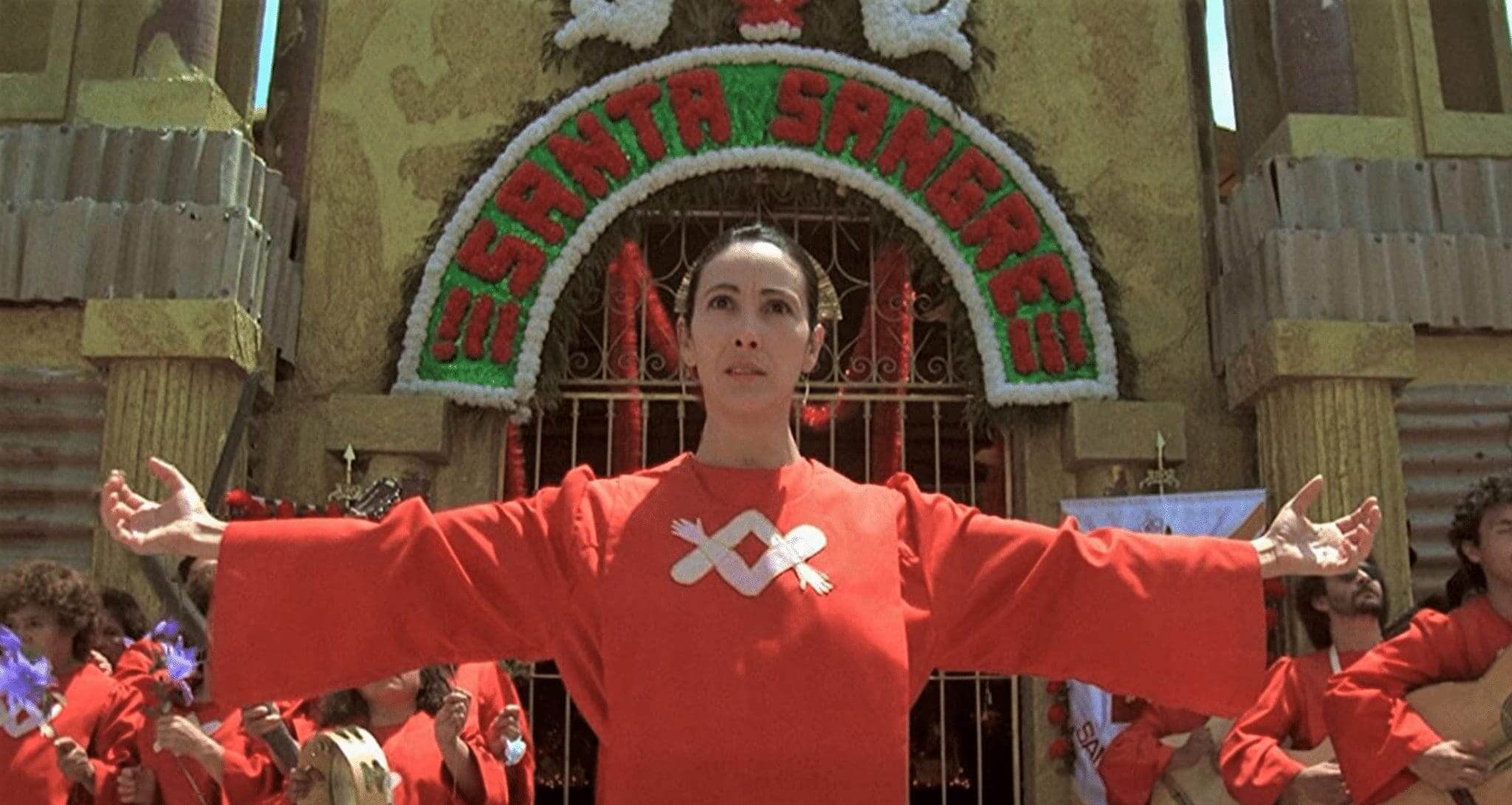Every time I’ve sat down to watch the psychedelic cinematography of Alejandro Jodorowsky, it has been a life-changing experience. From the first time I watched the Holy Mountain by a complete fluke, I have been blown away by his keen eye for color and framing, not to mention his narratives on violence and religious redemption. Plus, Jodorowsky is just a fascinating character in general. But after watching Santa Sangre, his 1989 venture into horror, this past weekend, I knew I had found my new favorite movie. I knew I wanted to write about it because I felt it was perfect for this month’s theme.
Despite the Spanish title, and the fact that the film is set in Mexico, all the dialogue is in English. The story was written by Claudio Argento (brother of Dario Argento) and Italian screenwriter Robert Leoni. The premise is familiar, imagining what if Alfred Hitchcock’s Psycho happened at the circus instead of a motel? Many of Jodorowsky’s are semi-autobiographical. He brought his own personal experience to the film, having spent some of his formative years as a circus clown. He really made it his own, casting two of his sons in the lead role (and two of his other sons in minor roles). In order to get total artistic control, Jodorowsky had to fundraise and cut through red tape for close to six years. But it all paid off in the end. Critics were blown away, and Santa Sangre became one of the few horror movies awarded four stars by Roger Ebert, who called it “one of the greatest.”

Fenix (Axel Jodorowsky) is cursed with what’s best described in psychological textbooks as “circus trauma.” As a young boy (the younger version played by Adan Jodorowsky), he witnessed his father, a famous knife-thrower, kill himself after he chopped off both of his wife’s arms. Years later, he is a shell of a man living in a mental institution. While on a field trip to the red light district, he spots someone from his past. The incident wakes him out of his catatonic state, and he finally has the mental capacity to escape from his enclosure. Upon escaping, he reunites with his armless mother after years of being apart. Together, they start a new cabaret act; his mother sings while Fenix stays close behind, acting as her hands.
His mother Concha (Mexican soap actress Blanca Guerra) is more than a former trapeze artist. In her past life, she founded a temple based around a dead schoolgirl who had her arms cut off (a running theme) by rapists. Concha encouraging her cult followers to bathe in the girl’s blood. She is incredibly jealous of her husband’s mistress and is fully prepared to cut a bitch if she catches him sleeping around.
“[…] what if Alfred Hitchcock’s Psycho happened at the circus instead of a motel?”
She does a real number on her adult son’s head. She constantly tells him tells him he is nothing without her, that the spectators only come to see her. He is constantly living in her shadow, not allowed to have his own time in the spotlight. Fenix wishes to disappear, like in his favorite movie, the 1933 film adaptation of H. G. Wells’ the Invisible Man. In a perfectly framed shot, Fenix swallows a concoction in an attempt to make himself invisible. As he unwraps the bandages covering his face, the iconic scene from Invisible Man plays off on the side on a small TV in front of a painted mural of the movie poster. To his horror, he is still visible.
As the movie progresses, it becomes more and more clear that Fenix and Concha have a Norma/Norman Bates relationship. Fenix has a bizarre oedipal connection to his mother; they sleep in the same bed and his mother won’t let him get close to any other woman out of fear that Fenix will abandon her if he ever falls in love with someone else. Or maybe she’s worried about Fenix becoming too much like his father.

Out in public on his own, Fenix is charming and easily catches the eye of single women who also happen to be performers. But when he takes them home, his mother ruins the moment, telling him to kill his romantic interests. Fenix has no control over his own hands. They belong to his mother and he feels he must obey her will. He fashions his hands with long red nails, and his mother’s dresses are specifically designed so that Fenix can slip his hands through her sleeves from behind. His inability to control his homicidal hands brings to mind the story of 1924 silent film the Hands of Orlac.
Axel and Guerra work perfectly together. Having learned from the famous French mime Marcel Marceau, Axel manipulates his arms with a graceful fluidity, anticipating Guerra’s every move. Fenix is torn between the masculine and feminine, trapped between his father’s promiscuous nature and his mother’s puritan beliefs. As a result, he’s scared of his own sexuality, plagued by nightmares and vivid hallucinations in his waking life. For example, at one point, he imagines being strangled by snake coming out of his pants (interpret that however you will). Freud would be fascinated by such a case.
“As the movie progresses, it becomes more and more clear that Fenix and Concha have a Norma/Norman Bates relationship. “
Like the shower scene in Psycho, Fenix is obscured during his first kill. It’s set up like a giallo scene, where the perpetrator is unseen, all we see are their hands violently stabbing, cut between the victim’s mortified reaction. Blood sprays across the glowing red room. Like a murder mystery, Alma (Sabrina Dennison), a deaf-mute girl who also grew up in the circus along with Fenix, discovers the string of crime scenes after the fact, but is unable to alert the authorities.
If you remain unconvinced of the similarities between Santa Sangre and Psycho, then you need to watch it until the end. I don’t want to give too much away, but if you’re familiar with how Psycho ends, then you can probably guess the major twist in Santa Sangre. There are so many other reasons to watch it, if not for the story of psychological torment, then for the colorful visuals, its weird theatricality, or the carnival sideshow of background characters. If you love directors like Wes Anderson and David Lynch, but haven’t seen a single film by Jodorowsky, this would be a good place to start.
For more film retrospectives like this one, follow us on Twitter, Reddit, Facebook, Instagram, and Discord. And for all the best horror content online, stay tuned to Nightmare on Film Street.










